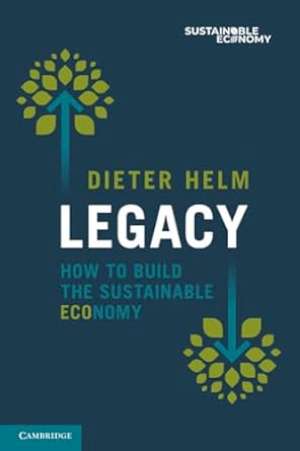21 March 2024
Legacy
How to Build the Sustainable Economy
Dieter Helm
2024, Cambridge University Press, 249 pages,
ISBN 9781009449229
Reviewer: Kevin Gardiner, Rothschild & Co/Cardiff Cap Region

Sir Dieter Helm, an Oxford Professor and Fellow, is one of our most respected economists, specialising in energy, utilities and regulatory policy. His analysis in this very readable book, refreshingly uncluttered by irrelevant maths, is sobering, but not apocalyptic: as he concludes, “The legacy we leave is for us to choose” (p227).
Helm does not say – as many do – that we are doomed to stagnating living standards and worse. Rather, he suggests that “The sustainable economy can and will grow, and potentially strongly, as a result of the growth of ideas, knowledge and technology.” (p225). But he pulls few punches in talking about what needs to be done if that is to happen.
He argues for a wholesale reorientation of our economic focus, away from what he sees as a Keynesian preoccupation with flows (in particular, spending) and towards an emphasis on stocks (that is, our collective assets).
Specifically, he advocates three big adjustments needed for economic activity to be sustainable: we need to take fully into account the cost of maintaining (and ideally augmenting) our collective capital; we need to consume less to make room for the relevant investment; and in accounting properly for externalities, it should be the polluters who pay.
Much of these adjustments will fall most heavily on the poorest, so there also needs to be a reappraisal of income support. And all this needs to happen alongside a holistic, systems-oriented approach to public goods and regulatory frameworks (the Welsh government’s innovative 2015 Well-being of Future Generations Act came to my mind here).
Because of this wide scope, he devotes roughly a quarter of the book to familiar topics: he offers a recap of modern macroeconomic thought, alongside an introduction to social justice and constitutional theories. For what it’s worth, I share his scepticism about the Keynesian obsession with the spending side of the national accounts, and welcome his willingness to be unfashionable in distinguishing between inequality and poverty.
For me, the strongest parts of the book focus on what he calls “The Capitals”, our collective natural, physical, human and social assets, and his thoughts on externalities and public goods. He also sidesteps neatly two of the issues which can bedevil discussion of future generations’ welfare: namely, how far forward we should look, and what discount rate we should use. He suggests pragmatically that it is human nature to care most about those who are closest to us in time, and that the real discount rate should be positive (which, after the Stern report, and the last decade’s negative real rates, is more prescriptive than it sounds).
I am not so sure about the scale of the rethink needed. That preoccupation with spending has indeed left macroeconomists with little to say about what we make and why, and badly placed to withstand today’s growth panic. But the ideas we need are surely all there already, they just need to be better articulated and interpreted: flows and stocks can be reconciled (literally, integrated) by a more comprehensive asset register and depreciation charge. That said, Helm does a thorough job of describing how today’s real balance sheets are far from complete. The book could perhaps benefit from some tables and charts, but then one of its themes is the paucity of data on the degradation of assets.
I am also unconvinced by the references to financing, and in particular the suggestion that debt per se can place a real burden on future generations if it is not accompanied by the creation of real assets. As we go about redirecting our current economic activity, the key variables are real, physical things, relative prices, and the rules of the game. Globally, collective economic activity is “pay as you go”, and financial balance sheets may not be relevant.
But overall, for me this is a welcome, balanced attempt to acknowledge the scale of the governmental – and statistical – effort needed if we are to carefully integrate our environmental and economic concerns.
